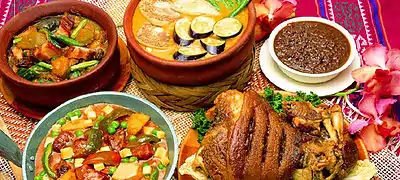Turon (food)
Turon (Tagalog pronunciation: [tuˈɾɔn]; also known as lumpiang saging (Filipino for "banana lumpia") or sagimis in dialectal Tagalog, is a Philippine snack made of thinly sliced bananas (preferably saba or Cardaba bananas), rolled in a spring roll wrapper, fried till the wrapper is crisp and coated with caramelized brown sugar.[1] Turon can also include other fillings. Most common is jackfruit (langka), but there are also recipes with sweet potato (kamote), mango (mangga), cheddar cheese and coconut (niyog).
 | |
| Alternative names | Sagimis, Turrón de banana, turrón de plátano, lumpiang saging |
|---|---|
| Type | Snack |
| Place of origin | Philippines |
| Main ingredients | Bananas, brown sugar |
Turon, though etymologically Spanish in origin, bears no similarities to the Spanish candy turrón (an almond nougat confection).[2]
It is a crunchy and chewy snack most commonly consumed during merienda or for dessert.[3]
It is also a popular street food,[4] usually sold with banana cue,[5] camote cue, and maruya.[6]
History

It has been speculated that turon making might have began in communities in the Philippines that were located near banana trees and crop fields. The extras would be given to locals when there was a surplus from the harvest, and eventually sold on the roadside.[7]
In Malabon, the term "turrón" or "turon" instead refers to a fried, lumpia-wrapper-enveloped dessert filled with sweet mung bean while the term valencia is used for the banana-filled variety. Malabon banana turon are generally sold as valencia trianggulo, which are uniquely triangle-shaped.[8][9]
It is believed that the creation of turon was linked to the presence of Chinese culture in the Philippines prior to being colonized by Spain beginning in 1521.[10] Other traditional Filipino dishes like pancit show use of Chinese cooking techniques. [11] There have been many inspirations within Filipino culture from Chinese culture and Spanish culture. In relation to Chinese cuisine, one of which includes spring rolls and egg rolls, Filipino cuisine includes lumpia (a savory meat and veggie-filled eggroll) and turon.[12]
References
- "How to Make Turon (Filipino fried banana rolls)". Serious Eats. Retrieved November 21, 2021.
- "Filipino Snack: Turon". ABOUT FILIPINO FOOD. April 25, 2019. Retrieved November 21, 2021.
- "Turon, cues - Manila, the Philippines - Local Food Guide". eatyourworld.com. Retrieved November 21, 2021.
- Home Cooking Rocks website accessed on November 16, 2010
- Turon recipe
- "Manila", Wikipedia, November 18, 2021, retrieved November 21, 2021
- Ho, Julee. "History of Fried Bananas (Turon)". Julee Ho Media. Retrieved November 21, 2021.
- "Recipe #43: BANANA TURON (Valencia)". Luto Ni Lola. Retrieved April 10, 2019.
- Aspiras, Reggie. "Valencia 'triangulo,' sacred cookies and 'leche flan' cheesecake–more reasons to celebrate the season". Philippine Daily Inquirer. Retrieved April 10, 2019.
- "120 years after Philippine independence from Spain, Hispanic influence remains". NBC News. Retrieved November 21, 2021.
- "Who created Turon? – MVOrganizing". www.mvorganizing.org. Retrieved November 21, 2021.
- "The lasting influence of Chinese culture on Filipino cuisine". Chibundle. Retrieved November 21, 2021.


